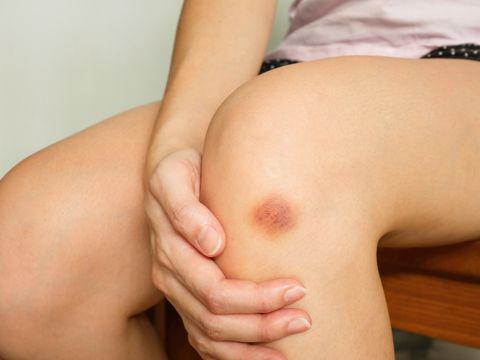“Ouch! That’s going to be a bruise.” If you have ever seen a phone screen shatter from a seemingly small height, you might have an appreciation for just how amazing our body is at managing impacts. Following around a toddler for a half hour could give you the same perspective. Sometimes those everyday hits we take turn into black and blue signs of an accident, injury, or trauma and are worth our attention. Read on to find out what messages a child’s bruises could be sending you, the best ways to respond, and when to seek medical attention.
How can I treat a bruise?
If you or your child has a bruise that needs care here are some easy steps to take to provide some relief and encourage healing. The first thing to note is that you should NOT put an ice pack directly on the skin of a child or baby. This can cause damage to the skin and create even more problems to deal with, not to mention even more pain to an already sensitive area. Instead, here are the steps you should follow:
- Wrap a towel around a bag of ice or an ice pack and place on the bruise for 10-15 minutes.
- Repeat this several times throughout the day, but no more than one time per hour.
- Continue with ice on the area for the first 24-48 hours.
Is my bruise a serious issue or a small incident?
Certain signals can send a message that more serious conditions may be present. Harvard health describes a bruise occurring “when an injury of some sort breaks tiny blood vessels, called capillaries, which then bleed under the surface of your skin, creating that familiar black-and-blue mark.” What types of bruises are cause for concern? Bruising as a result of head trauma should always be treated with the utmost precaution. For instance, a bruise behind the ear could point towards the presence of a fracture somewhere in the skull.
Bruises that appear without explanation can signal other medical conditions like blood disorders. When a bruise stays around for more than two weeks or is joined by other symptoms like a fever or infection, there may be something else at play. In all of these instances it is a good idea to seek advice from a medical professional.
When should I seek medical attention for bruise?
- The bruise occurred because of a serious accident.
- The bruise occurred because of head trauma.
- The bruise seems infected or swollen.
- The child is running a fever along with the bruise.
- The bruise is behind the ear which could indicate a skull fracture.
- Many unexplained bruises appear that are not results of injuries. This may be an indication of a blood disorder.
- The bruise persists for more than two weeks.
How can I tell if bruising is the result of abuse?
Bruising on children can also send other serious messages. Medical professionals often pay attention to bruising that occurs in unlikely places and could signal that the child has experienced abuse. Norton Children’s Hospital identifies “bruises don’t have to be large in order to be significant — much depends on their location on the body.” Bruises on the abdomen, buttocks, or upper arms are uncommon in the course of normal play. In addition, abnormal clusters of bruises or bruising in the shape of a hand slap can signal the potential of abuse. Multiple stages of bruising present on a child provide a clue that the child may be experiencing ongoing abuse. If any of these signals are present, the child should be seen in an emergency department as soon as possible.
Even if you are not sure, it is important to contact child protective services in your state. In some cases, like in the instance of caregivers or education professionals you may be required by law to make a report of signs of abuse that you have seen. Your action can make a huge difference in intervening in the cycle of abuse on behalf of a child.



